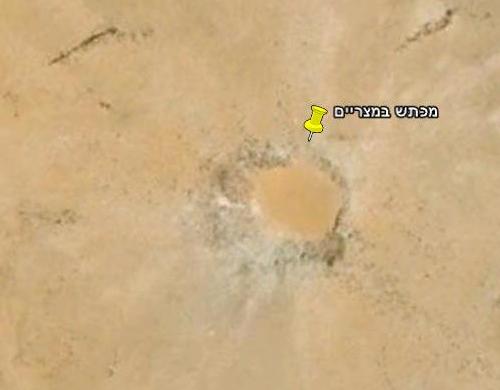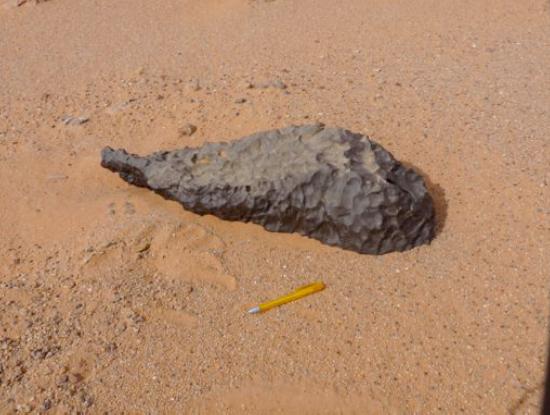The crater, with a diameter of 45 meters, was discovered through a Google Earth search. An Italian-Egyptian delegation went to the field and also discovered the remains of the metallic meteorite

Researchers from the University of Siena in Italy have uncovered a small impact crater in Egypt that was not known until now. The crater known as Kamil, with a diameter of 45 meters in total, is among the most perfect of the known impact craters. While most of the craters have been eroded, this crater has been preserved in its original structure, so even the materials that were thrown and projected in all directions are still there. Most such preserved craters are found on the Moon or Mars where there are fewer environmental and atmospheric processes that destroy them.
Camille Crater was discovered by another Italian explorer named Vincenzo De Michele, former curator of the Natural History Museum in Milan when he reviewed Google Earth photographs. The remains of the meteorite, weighing 83 kg, were discovered about 230 meters from the crater. on February 28-25 A joint Italian-Egyptian delegation toured the place and the results of which were published this week.
about the research Published on Thursday (July 22, 2010) in the journal Science Signed by Prof. Luigi Polco, curator of meteorites at the Museo Nazionale dell'Antartide in Siena, Italy, belonging to the University of Siena, and 18 researchers from universities and institutes in Italy, as well as from Cairo University in Giza and the Institute of Astronomy and Astrophysics in Helwan, Egypt.

In the introduction to the article they write: "We reported on the discovery of an ancient impact crater with a diameter of 45 in southern Egypt with a horn structure. This primary structure is mostly common in rocky planetary bodies that lack an atmosphere in the solar system. "Tichthonez and the connection to the iron meteorite and the transformation that the rocks went through provide us with a unique picture of the impact of small objects at high speeds on the Earth's crust. Contrary to the previous geophysical models, the ground data indicate that an iron meteorite with a mass of tens of tons can penetrate the atmosphere without disintegrating significantly."
Based on the characteristics of the bowl-shaped crater covered in sand, the researchers believe that it was caused by a meteorite impact with a diameter of 1.3 meters moving at a speed of 11,732 km/h.
"It is a beautiful crater because it has been preserved so well and can tell us a lot about the impact of small meteorites on the Earth," said Prof. Polko. It is estimated that the crater is only a few thousand years old.

19 תגובות
How to add a picture here
Maybe in a few years we will be able to see pictures of the meteorite on its way to Earth in Microsoft's WorldWide Telescope software 🙂
Yigal on Google and as it is written in the article the diameter is about 45 meters. Why 300?
In measuring the diameter on Google, the diameter of the crater does not exceed 300 m. Does anyone have an explanation?
Well done to Google.
Father, you can put a link to photos or other information in the article with the source. It's legal.
1 I'm sorry I happened to be in the western desert in Egypt on a trip 4 years ago. There is nothing to compare with the Israeli Negev in terms of its huge size and power, there is no doubt that the Negev is beautiful but not as powerful and huge as in Egypt.
I would appreciate it if you could send us a screenshot of Google Earth with these coordinates.
Shabbat Shalom,
What metals does this small stone contain that makes it so heavy?
Thanks
Google Earth:
Latitude: 22° 1'6.72″N
Longitude: 26° 5'15.83″E
Thank you, father, in any case, although I was not clear, my criticism was directed only at the authors of the original article, I saw through the link that there are no pictures of the crater either, I do not understand what goes through the mind of a reporter who writes an entire article about such a perfect impact crater in Egypt and does not even think to show One image for illustration.
to the opponent I could not find the image without copyright. In the study itself it does not appear, but the image I used and several other images appear.
The picture of the crater can be seen here:
http://bit.ly/a8q3Lb
Well, I found some pictures, but I really don't understand why they didn't think it was appropriate to show some pictures in the article itself, what senselessness.
http://www.space.com/php/multimedia/imagedisplay/img_display.php?pic=Egypt-new-impact-crater-100722-1-02.jpg
http://www.space.com/php/multimedia/imagedisplay/img_display.php?pic=Egypt-new-impact-crater-100722-2-02.jpg
Can you understand why there is not one picture of the crater? Throughout the article it is described how perfect, and beautiful, and well preserved this crater is, but no one thought to show a photograph of it? Where is the logic here?
The disturbing part of the article is this quote: "Contrary to previous geophysical models, the ground data indicates that an iron meteorite with a mass of tens of tons can penetrate the atmosphere without significantly disintegrating."
If this is indeed how things turn out, then it is possible that the probability that severe impacts of meteorites on the Earth causing significant damages are more common than previously thought. And if this is indeed the case, it may be necessary to rapidly advance the ideas and then the various projects to protect the earth from their harm.
I found it according to the coordinates in the original article attached to the article.
It is located in the southwest of Egypt.
Very nice !!!
Quote: "Moving at a speed of 11,732 km/h."
I am "stunned" by the accuracy of the speed figure, but isn't there an excessive translation of other measurements here? After all, we don't really know the speed up to meters per hour.
I'm also missing the picture of the crater in question.
Shabbat Shalom
Sabdarmish Yehuda
Is it possible to get coordinates or a more precise location so that we can find it on Google Earth?
The deserts of Egypt really look like Mars, no wonder it has been preserved so well, even in Israel up to the line of Beer Sheva the surroundings look like Mars.